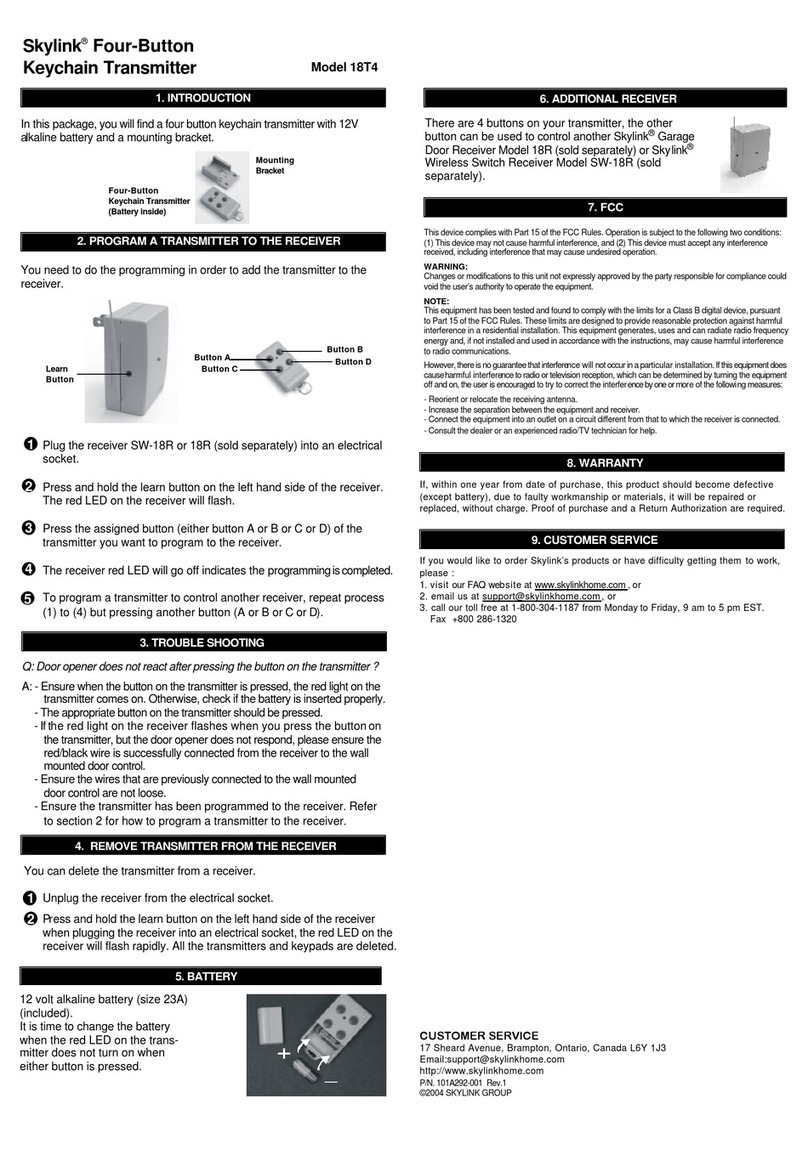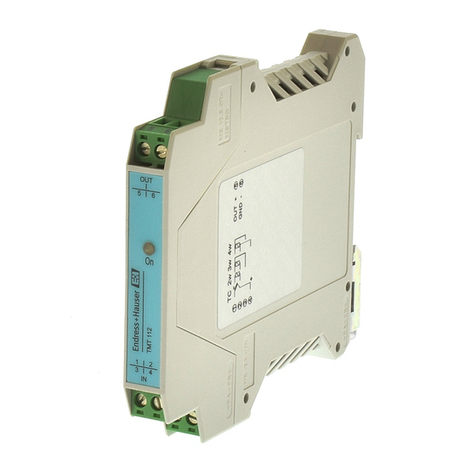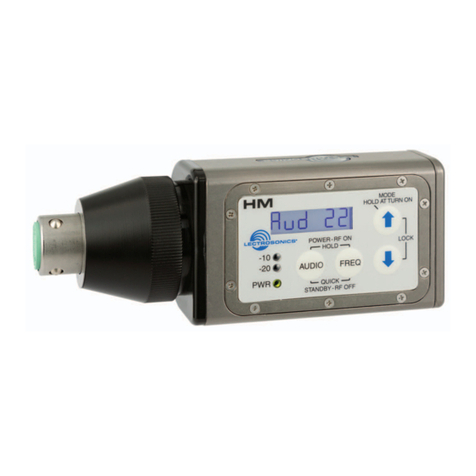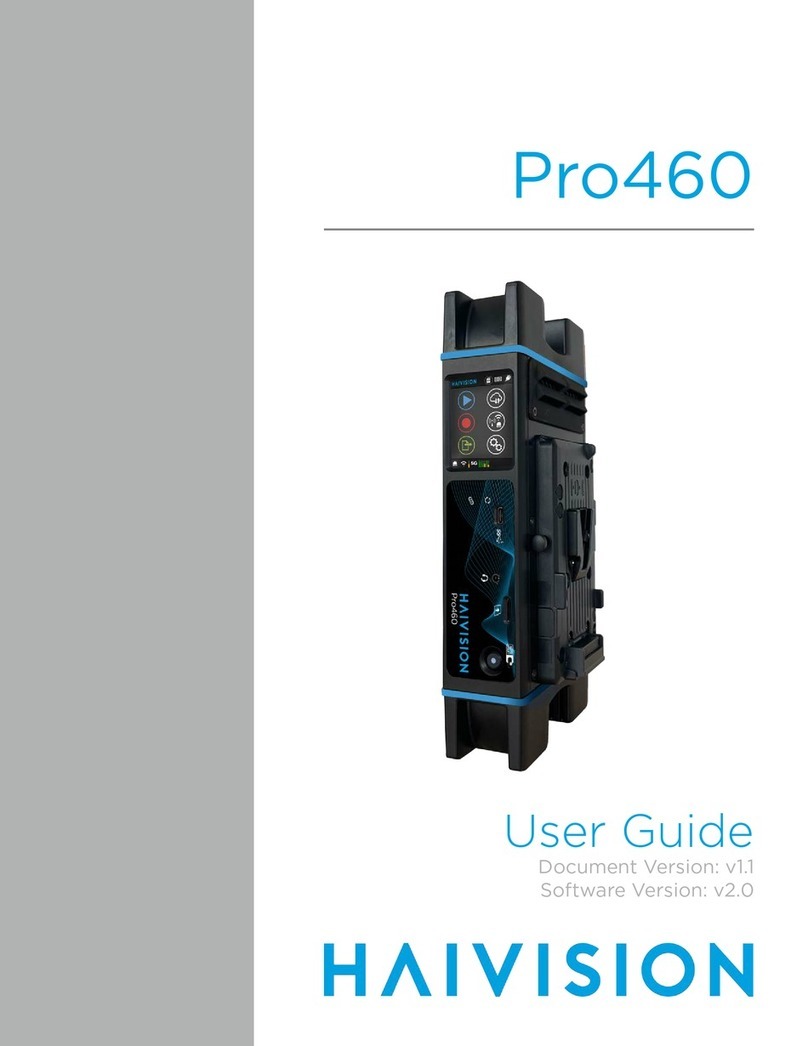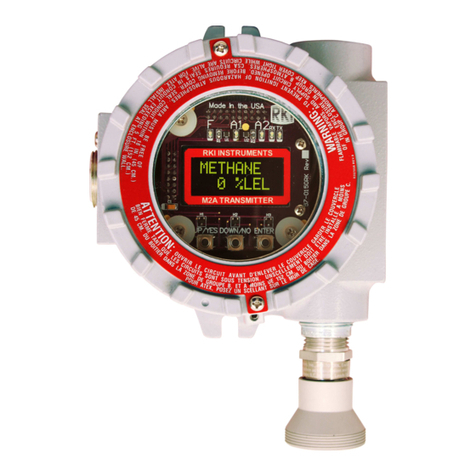Gemini Domus 5000 CT User manual

5000 CT
5000 CT
This transmits a battery low signal which is acquired by the control unit in the zone where the
device has been memorised. The dedicated output is also activated (terminal 22) for 30
seconds.
To replace the battery proceed as follows:
1. Access the programming function (see paragraph 3.1 in the installation manual). In these
conditions, in fact, the control unit does not detect the sabotage alarm caused by the opening
of the sensor.
2. Open the sensor cover by pulling out the cap at the centre of the cover and removing the
fastening screw underneath.
3. Replace the battery and, if desired, check the radio transmission (SYSTEM TEST).
4. Close the cover.
5. Quit the programming function.
TECHNICAL DATA
Power supply 1 9V alkaline battery
Operation with battery charged ca 1 year
Range of transmitter in free air 20 m
Transmission frequency 433.92 MHz
Thisdeviceiswarrantedagainstallconstructionoroperatingdefectsforaperiodof12monthsofthedateofmanufacture
givenonthewarrantylabelontheback.Ifthislabelismissingthewarrantylosesitsvalidity.Themanufacturerassumes
noresponsibilityforanomaliesorfailurestothealarmdevicecausedbytransportorextraneouscausessuchaselectric
discharge,overvoltage,mechanicalimpact,flooding,orduetoimproperinstallationornoncompliancewiththetechnical
data specified. The alarm has only dissuasive functions against theft.
5000IS-CT-Rev.00/07/01
5000IS-CT-Rev.00/07/01
This transmits a battery low signal which is acquired by the control unit in the zone where the
device has been memorised. The dedicated output is also activated (terminal 22) for 30
seconds.
To replace the battery proceed as follows:
1. Access the programming function (see paragraph 3.1 in the installation manual). In these
conditions, in fact, the control unit does not detect the sabotage alarm caused by the opening
of the sensor.
2. Open the sensor cover by pulling out the cap at the centre of the cover and removing the
fastening screw underneath.
3. Replace the battery and, if desired, check the radio transmission (SYSTEM TEST).
4. Close the cover.
5. Quit the programming function.
TECHNICAL DATA
Power supply 1 9V alkaline battery
Operation with battery charged ca 1 year
Range of transmitter in free air 20 m
Transmission frequency 433.92 MHz
Thisdeviceiswarrantedagainstallconstructionoroperatingdefectsforaperiodof12monthsofthedateofmanufacture
givenonthewarrantylabelontheback.Ifthislabelismissingthewarrantylosesitsvalidity.Themanufacturerassumes
noresponsibilityforanomaliesorfailurestothealarmdevicecausedbytransportorextraneouscausessuchaselectric
discharge,overvoltage,mechanicalimpact,flooding,orduetoimproperinstallationornoncompliancewiththetechnical
data specified. The alarm has only dissuasive functions against theft.

Programming
To link up the sensor to the control unit, remove the cover and select the dip switches (from
No. 1 to No. 8) located in the printed circuit.
CAUTION: eachwireless peripheral must haveaunique code, different fromthoseof
all the other peripherals (see table at the end of the User Manual for possible double
codes).
Access the control unit programming function by following the instructions provided in the
installation manual (par. 3.1) and go to the “PROGRAM SENSORS?” menu (par. 3.4).
Assign a code to the sensor.
Assembly process
- Take down the blind box and identify the point where you want to install the contact and the
transmitter.
- Connect the eyelet to the blind contact
- Fasten the blind contact to the point selected inside the box
- Fasten the transmitter and connect it to the blind contact.
NOTE: The radio transmitter can be positioned either inside or outside the box,
depending on aesthetic requirements and ease of installation.
RF Test
Having assigned a code to the sensor, we recommend that you perform the RF test to verify
the presence of radio communications between the sensor and the control unit. For the RF
test, position dip switch no. 9 on “ON”. This will cause the cyclic emission of an RF signal
which is detected by the alarm system and visualised on the display when you enter the
“SYSTEM TEST” function (par. 3.10). At the end of the test, it is important to reset dip
switch no. 9 on “OFF” (normal operating mode).
Operating test
After fastening the 5000CT kit and having performed the RF test, make sure that the opening
of the blind results in LED DL1 flashing three times. This signal tells you that the alarm signal
is being transmitted and hence that the 5000CT kit is working properly.
Checking and replacing the battery
When battery voltage drops below 6 V, the sensor indicates this condition by giving out a
visual signal (LED DL2 lights up) with each movement of the blind.
The 5000CTis a kit consisting of a blind contact and a transmitter which converts the alarm
signal from wire to wireless.
9
Vo l
t
B a tter
y
ANTISABOTAGE
BUTTON
DIP-SWITCH
LED DL 1
LED DL 2
Terminal strip
Blind contact
Transmitter for
blindcontact
Programming
To link up the sensor to the control unit, remove the cover and select the dip switches (from
No. 1 to No. 8) located in the printed circuit.
CAUTION: eachwireless peripheral must haveaunique code, different fromthoseof
all the other peripherals (see table at the end of the User Manual for possible double
codes).
Access the control unit programming function by following the instructions provided in the
installation manual (par. 3.1) and go to the “PROGRAM SENSORS?” menu (par. 3.4).
Assign a code to the sensor.
Assembly process
- Take down the blind box and identify the point where you want to install the contact and the
transmitter.
- Connect the eyelet to the blind contact
- Fasten the blind contact to the point selected inside the box
- Fasten the transmitter and connect it to the blind contact.
NOTE: The radio transmitter can be positioned either inside or outside the box,
depending on aesthetic requirements and ease of installation.
RF Test
Having assigned a code to the sensor, we recommend that you perform the RF test to verify
the presence of radio communications between the sensor and the control unit. For the RF
test, position dip switch no. 9 on “ON”. This will cause the cyclic emission of an RF signal
which is detected by the alarm system and visualised on the display when you enter the
“SYSTEM TEST” function (par. 3.10). At the end of the test, it is important to reset dip
switch no. 9 on “OFF” (normal operating mode).
Operating test
After fastening the 5000CT kit and having performed the RF test, make sure that the opening
of the blind results in LED DL1 flashing three times. This signal tells you that the alarm signal
is being transmitted and hence that the 5000CT kit is working properly.
Checking and replacing the battery
When battery voltage drops below 6 V, the sensor indicates this condition by giving out a
visual signal (LED DL2 lights up) with each movement of the blind.
The 5000CTis a kit consisting of a blind contact and a transmitter which converts the alarm
signal from wire to wireless.
9
Vo l
t
B a tter
y
ANTISABOTAGE
BUTTON
DIP-SWITCH
LED DL 1
LED DL 2
Terminal strip
Blind contact
Transmitter for
blindcontact
Popular Transmitter manuals by other brands
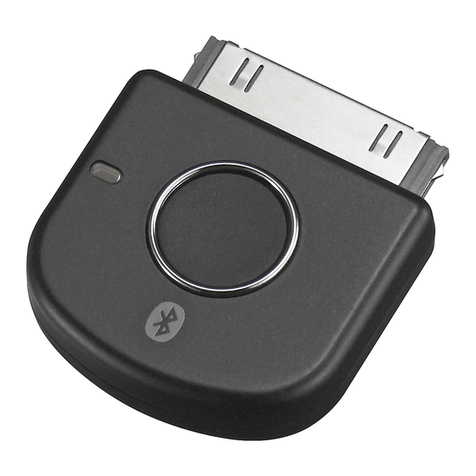
Sony
Sony TMR-BT8iP - Bluetooth Wireless Transmitter operating manual
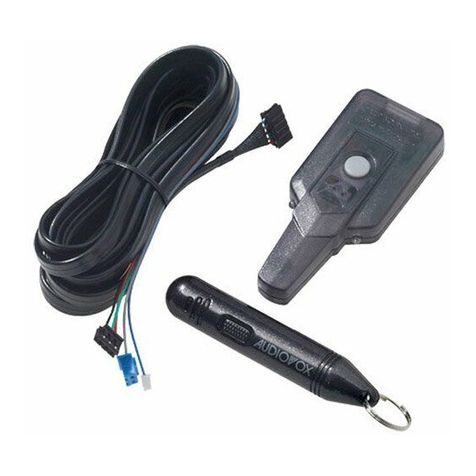
Audiovox
Audiovox ADDP1 Install & transmitter programming guide
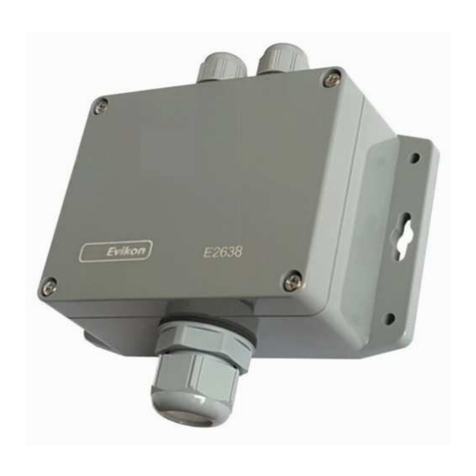
Evikon
Evikon PluraSens E2638-HFC user manual

Sony
Sony TMR-BT8iP - Bluetooth Wireless Transmitter operating instructions
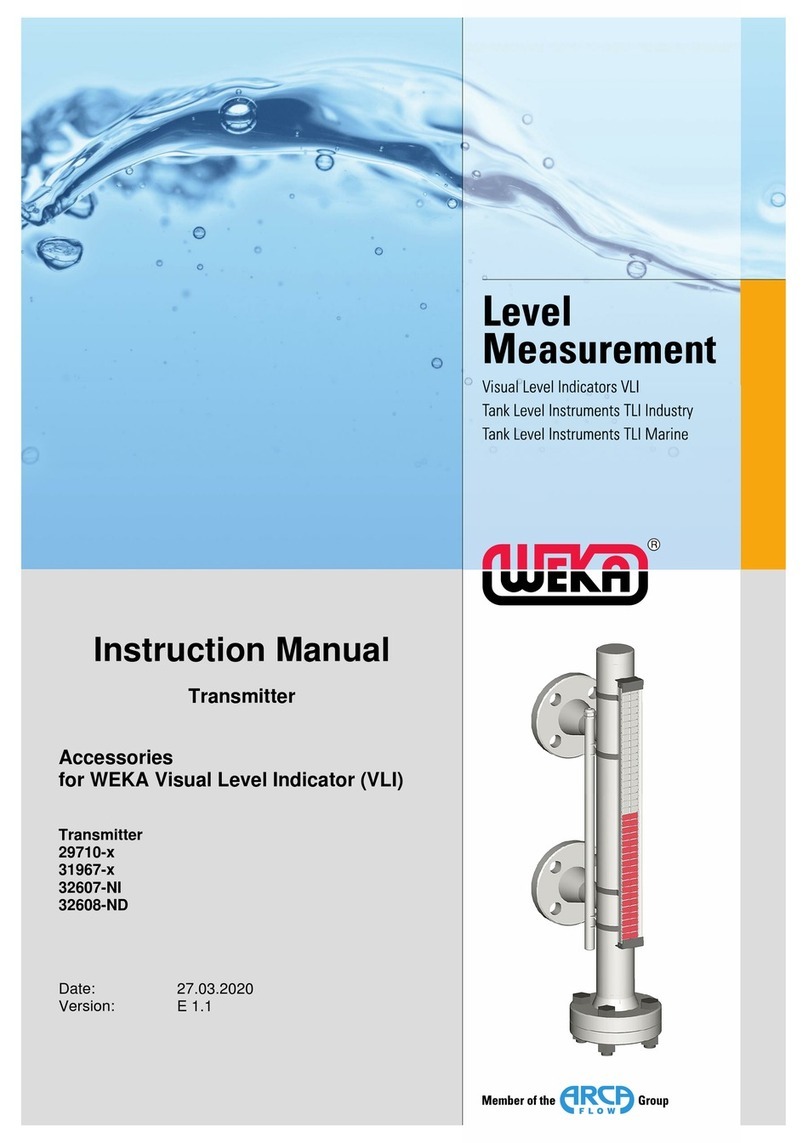
ARCA
ARCA WEKA 29710 Series instruction manual
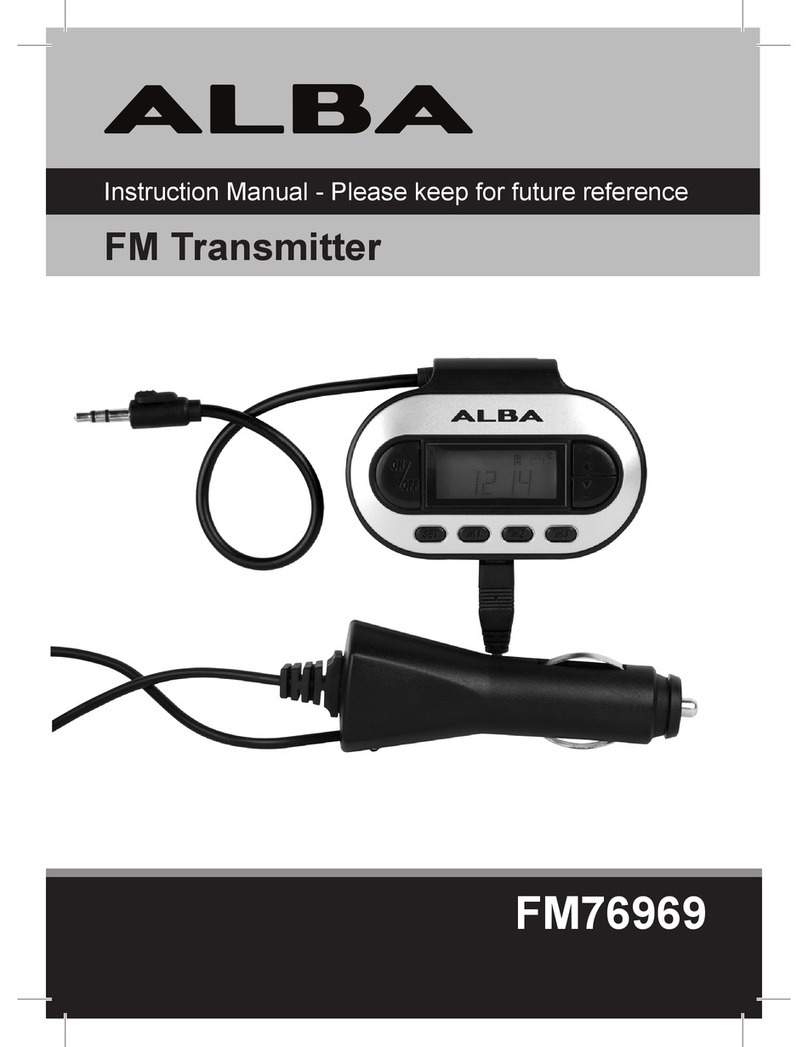
Alba
Alba FM76969 instruction manual


